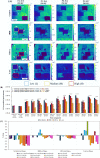Exploring New Methods to Study and Moderate Proton Beam Damage for Multimodal Imaging on a Single Tissue Section
- PMID: 36398943
- PMCID: PMC9732869
- DOI: 10.1021/jasms.2c00226
Exploring New Methods to Study and Moderate Proton Beam Damage for Multimodal Imaging on a Single Tissue Section
Abstract
Characterizing proton beam damage in biological materials is of interest to enable the integration of proton microprobe elemental mapping techniques with other imaging modalities. It is also of relevance to obtain a deeper understanding of mechanical damage to lipids in tissues during proton beam cancer therapy. We have developed a novel strategy to characterize proton beam damage to lipids in biological tissues based on mass spectrometry imaging. This methodology is applied to characterize changes to lipids in tissues ex vivo, irradiated under different conditions designed to mitigate beam damage. This work shows that performing proton beam irradiation at ambient pressure, as well as including the application of an organic matrix prior to irradiation, can reduce damage to lipids in tissues. We also discovered that, irrespective of proton beam irradiation, placing a sample in a vacuum prior to desorption electrospray ionization imaging can enhance lipid signals, a conclusion that may be of future benefit to the mass spectrometry imaging community.
Conflict of interest statement
The authors declare no competing financial interest.
Figures






References
-
- de Jesus J. M.; Costa C.; Burton A.; Palitsin V.; Webb R.; Taylor A.; Nikula C.; Dexter A.; Kaya F.; Chambers M.; Dartois V.; Goodwin R. J. A.; Bunch J.; Bailey M. J. Correlative Imaging of Trace Elements and Intact Molecular Species in a Single-Tissue Sample at the 50 μm Scale. Anal. Chem. 2021, 93 (40), 13450–13458. 10.1021/acs.analchem.1c01927. - DOI - PubMed
MeSH terms
Substances
LinkOut - more resources
Full Text Sources

